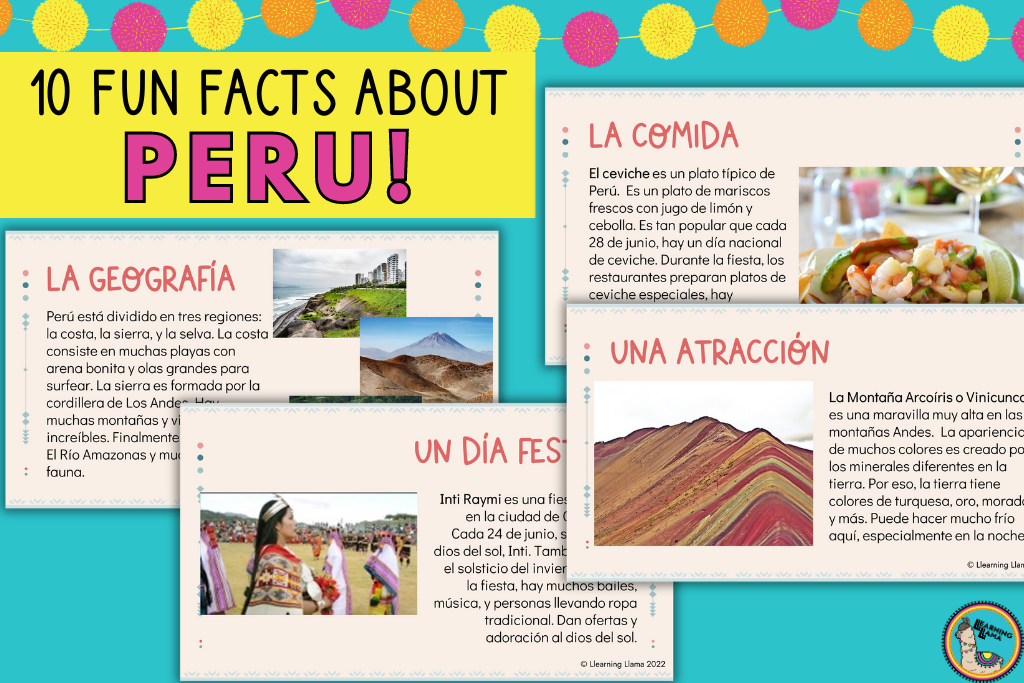Do you ever teach about one specific Spanish-speaking country? Maybe you have a Peru Culture unit or a Spain Food unit or a Argentina Music unit? Trying to find the best material and resources to teach about a specific country can be challenging, especially if you have never traveled there. Let me share my best resources for a Peru Culture unit with you!
In 2017, I was fortunate enough to travel to Peru. My husband (who was then my boyfriend), and I took a vacation to Lima, Cusco, and Machu Picchu. It was always on my bucket list, so I was eager to plan this adventure. And it did not disappoint! I fell in love with the country and culture of Peru. Any chance I get to share about my trip with my students, I share pictures, stories, and more! I’m sure that if you ever traveled to or studied abroad in another country, that you feel the same way about that country. It must hold a special place in your heart, and you want your students to know!
But sometimes, our curriculum lends itself to teaching about specific countries or topics that we are not as familiar with. So, we head to the Internet to research the best cities, cultural facts, cuisine, traditional holidays, and more. The results can be overwhelming. So, I’m sharing with you the best resources to teach about Peru in Spanish class.
Places to “Visit” With Your Students
When teaching about a whole country, it can be difficult to narrow down the locations of where you want to “take” your students. Obviously you want to share about the capital city and major tourist destinations. If you’ve had the fortune of traveling to said country, then you will probably want to take them to the cities and locations that you visited and enjoyed.
But,if you’ve never been to Peru how would you know which cities and destinations are best suited to teach your students? As I said I’ve been blessed to go and visit Peru here are my favorite places to teach my students, along with resources that will save you time and research:
Machu Picchu
The Ministerio de Cultura de Peru has a website filled with tourist information, ticketing, and historical facts about Machu Picchu. Did you know there is a museum near Machu Picchu and you can take a virtual tour of it on this site!
I also recommend highlighting the awe of this beautiful site with some videos:
In addition, you can use Google Earth to let students explore on their own. They jump into the ruins and walk around at their own pace. Here is my virtual field trip that will guide students through Google Earth stops in the Sacred Valley and Machu Picchu.

Lima
Lima is the capital of Peru, so you will probably touch on this a little bit. Here is a fun and simple reading comprehension activity about Lima.
If you’ve never been to Lima, Miraflores is a very artsy and unique barrio. It is worth mentioning this area to your students and maybe exploring the street art with this blog post from I Support Street Art.
Sacred Valley
The Sacred Valley is the stretch of land in the Andes region that consists of many villages and cities known for their cultural and historical significance, like Pisac and Ollantaytambo, but also Cusco and Machu Picchu. You can focus on any one part of the valley or take a brief overview of the many stops with your students. As I mentioned earlier, I have a Sacred Valley virtual field trip with the most important stops!
Cusco
Cusco is probably my favorite city, ever! The architecture, mountains, llamas, and more are breathtaking! I could have spent forever walking along the cobblestoned streets. Let your students explore a 360 Google Earth map to understand just how impressive the building of this city is. And learn about the history with this reading and activity set.

Pachas en Peru videos
As a fellow world language teacher, I know that finding authentic listening clips voiced by native speakers is challenging. I am here to provide you with a YouTube channel that you will want to bookmark and use forever! Pachas en Peru interviews native Peruvians about SO many different topics. Plus, the videos are broken down by proficiency level from beginner to advanced! Not only do they talk about the culture of Peru, but there are everyday topics like sports and family life that can be applied to any unit that you teach!
Inca Empire
Peru is synonymous with the Inca Empire. The ruins that millions of people visit each year were carefully designed and built by the Incas. It would be a disservice not to mention the quality of their craft and architecture and their lifestyle. I’ll mention some of the biggest parts of the Inca Empire below, but you can get much more detail on my other blog post: How To Teach About the Inca Empire or grab a set of resources for Spanish class here.
Inca Technology
When I taught Spanish 4, I taught a unit on technology and chose to incorporate the Inca empire into this unit because their use of “technology” for their time period was so advanced and impressive. Here are some great intermediate and advanced readings about the technology of the Inca Empire.
Myths and Legends
Teaching myths and legends in Spanish class is the perfect storm of culture and communicative tasks. Since myths and legends are so near and dear to the country or culture they belong to, students get an up-close look at the culture. Plus, with reading or listening, discussion, and cultural comparisons, the communicative possibilities with myths and legends are endless!
Here are some great myths and legends from Peru that can be used to enhance a country study! Plus, they all come in English or Spanish, with differentiated versions, vocabulary activities, reading comprehension, and more!
- The Legend of Rainbow Mountain
- The Myth of Lake Titicaca
- The Legend of the Llama
- El río hirviente (The Boiling River)

Facts of Peru
A fun way to introduce the culture of Peru is with fun facts. Share a fun fact each day as a bell ringer or create a gallery walk with fun facts around the classroom for students to peruse. From food to music to geography and more, your students will be immersed in cultural information! Grab your set of 10 fun facts in Spanish or English about Peru here, along with differentiated worksheets!

Plan a Trip
One of the most authentic ways for students to learn about countries in the world language classroom is to actually plan a trip, well “pretend” plan a trip. Using authentic travel websites like Peru Rail, students can imagine they are booking a trip, creating an itinerary, purchasing tickets, and more! Which train service would they prefer? What is the most cost effective way to get from Cusco to Machu Picchu? Ask them questions or let them plan their dream trip! Here is a webquest activity based on Peru Rail and planning a trip to Machu Picchu.
Llamas
If you can’t tell by the name of my blog, I love llamas! And Peru is known for llamas and alpacas. Talk about these animals, their uses, their popularity, and more! I love reading about the history of llamas or the legend of the llama with my students.

Geography
Here is an authentic audio clip from LAITS Spanish Proficiency Exercises that I like to use when introducing Peru to my students. Alejandro talks about the three natural regions of Peru. I turned this audio clip into a comprehensible input lesson and had my most successful demo lesson based on just this short clip! Learn how I based an entire (awesome) lesson on this one video clip and got my students talking about geographic regions of Peru.
Flip Book
For an interactive lesson, where students get a chance to do a hands-on activity, try a flip book! Students put together a multiple-page booklet with info on Peru! They will answer questions, read short passages, complete vocabulary activities, and more all about the main elements of Peru! It comes in Spanish or English.

La comida – Food Bracket
Peru is known for its cuisine! Make a March Madness style food bracket with the different popular and traditional dishes of Peru’s cuisine. Show videos, images, and even read recipes of the most famous dishes. Create a bracket with 8 popular food items. Showcase two at a time and let your class vote on which food they would prefer to eat. Then, by the end of the bracket, you will narrow it down to the two class favorites and they will vote for the ultimate Peruvian dish. If you have a small enough class, you may even want to make the two final food options to let your students get a real taste! You can search for videos or images online, like this one that showcases Peruvian cuisine.
Are you ready to take your students to Peru? With all of these activities, your students will really feel like they have traveled to the incredible sites of Peru, experienced the culture, and hopefully will be inspired to take a trip there.





